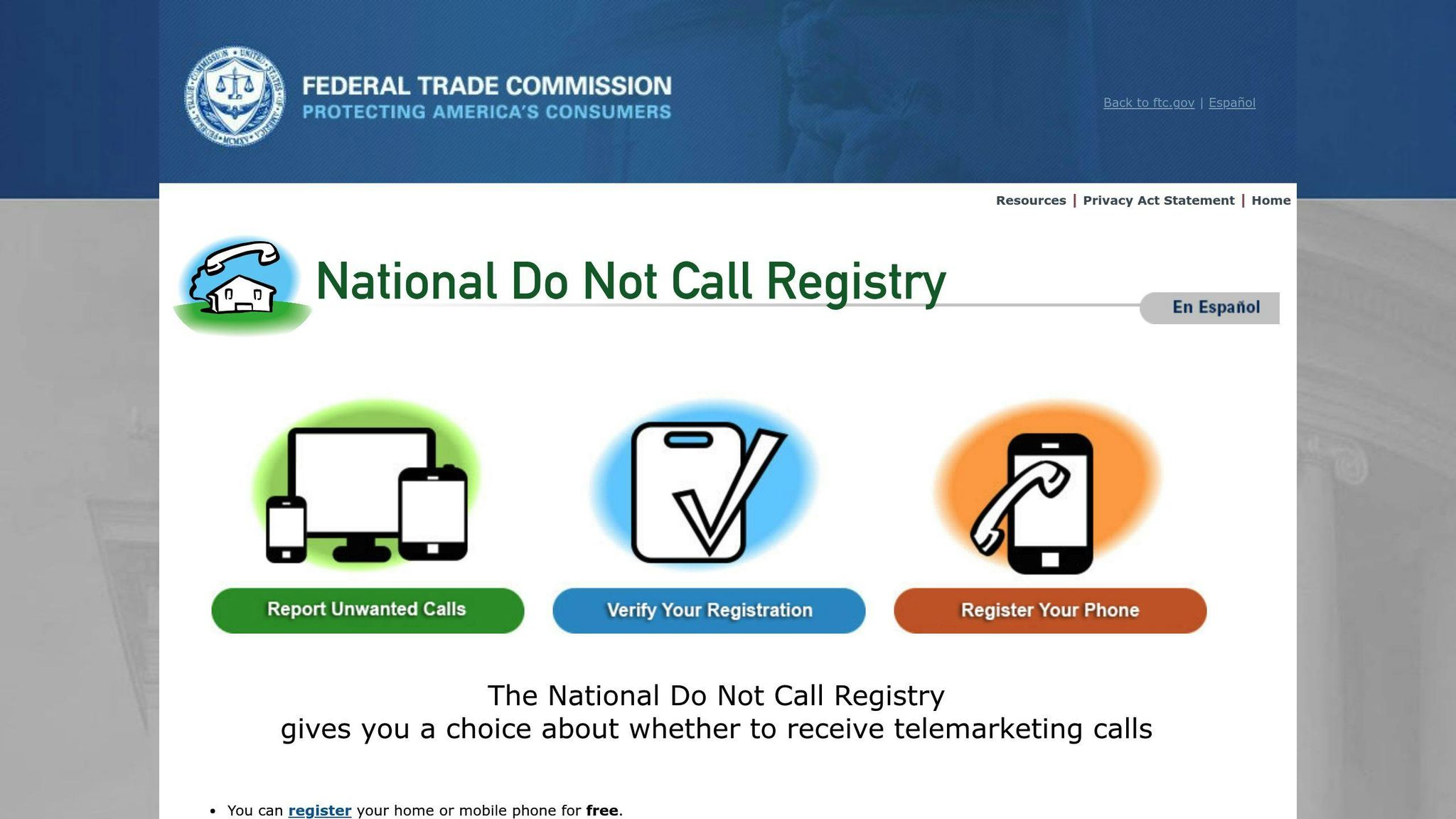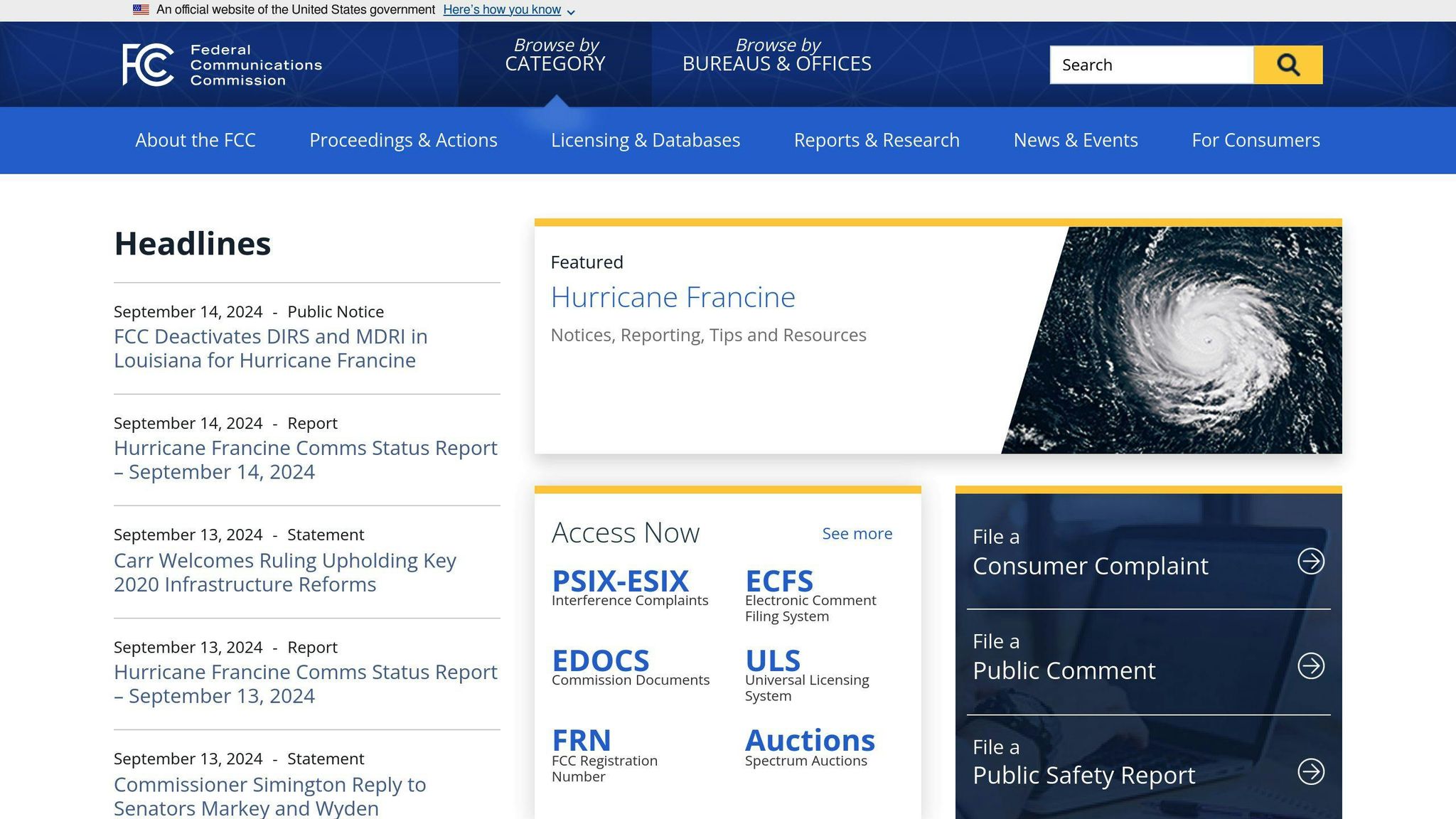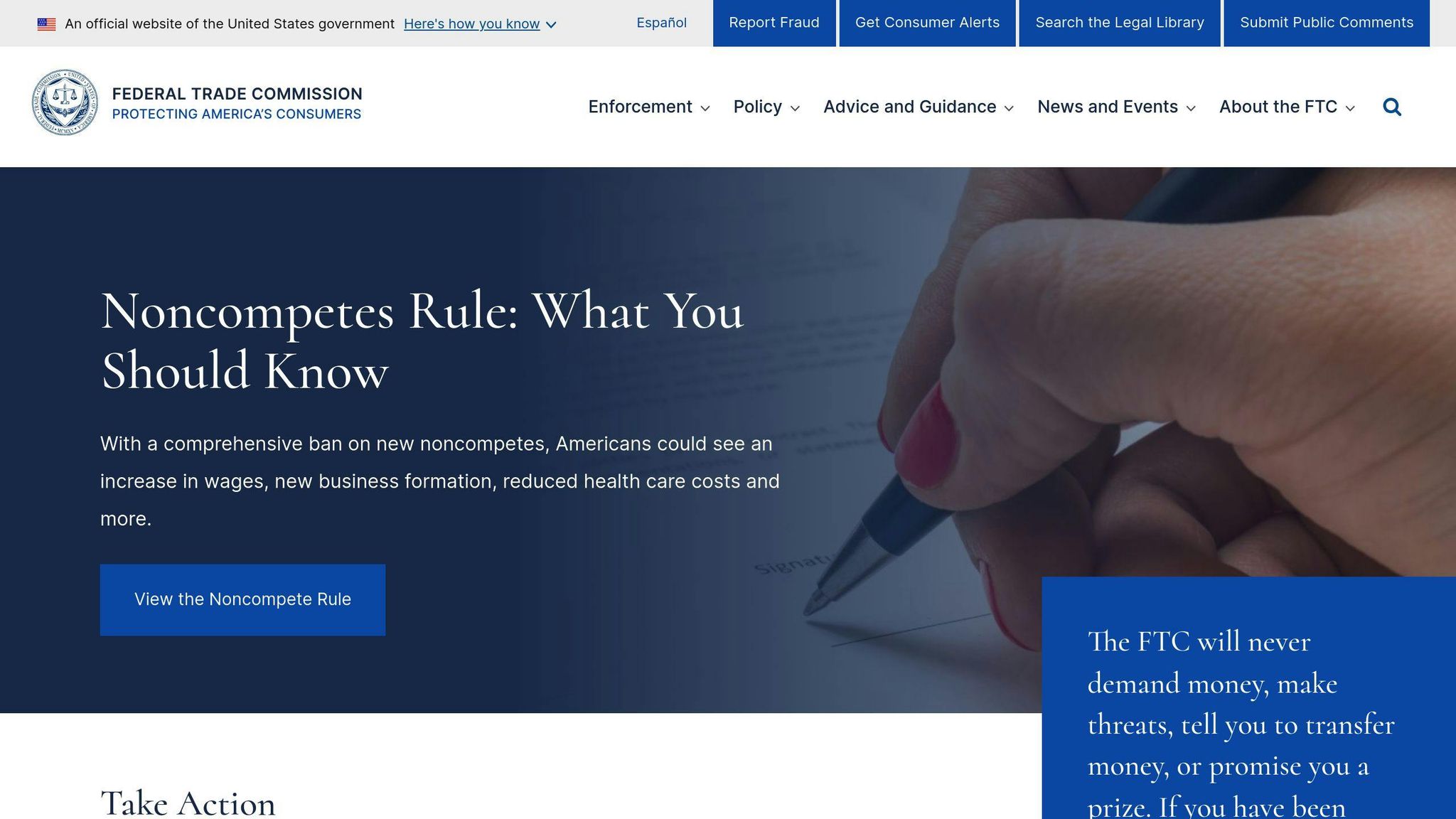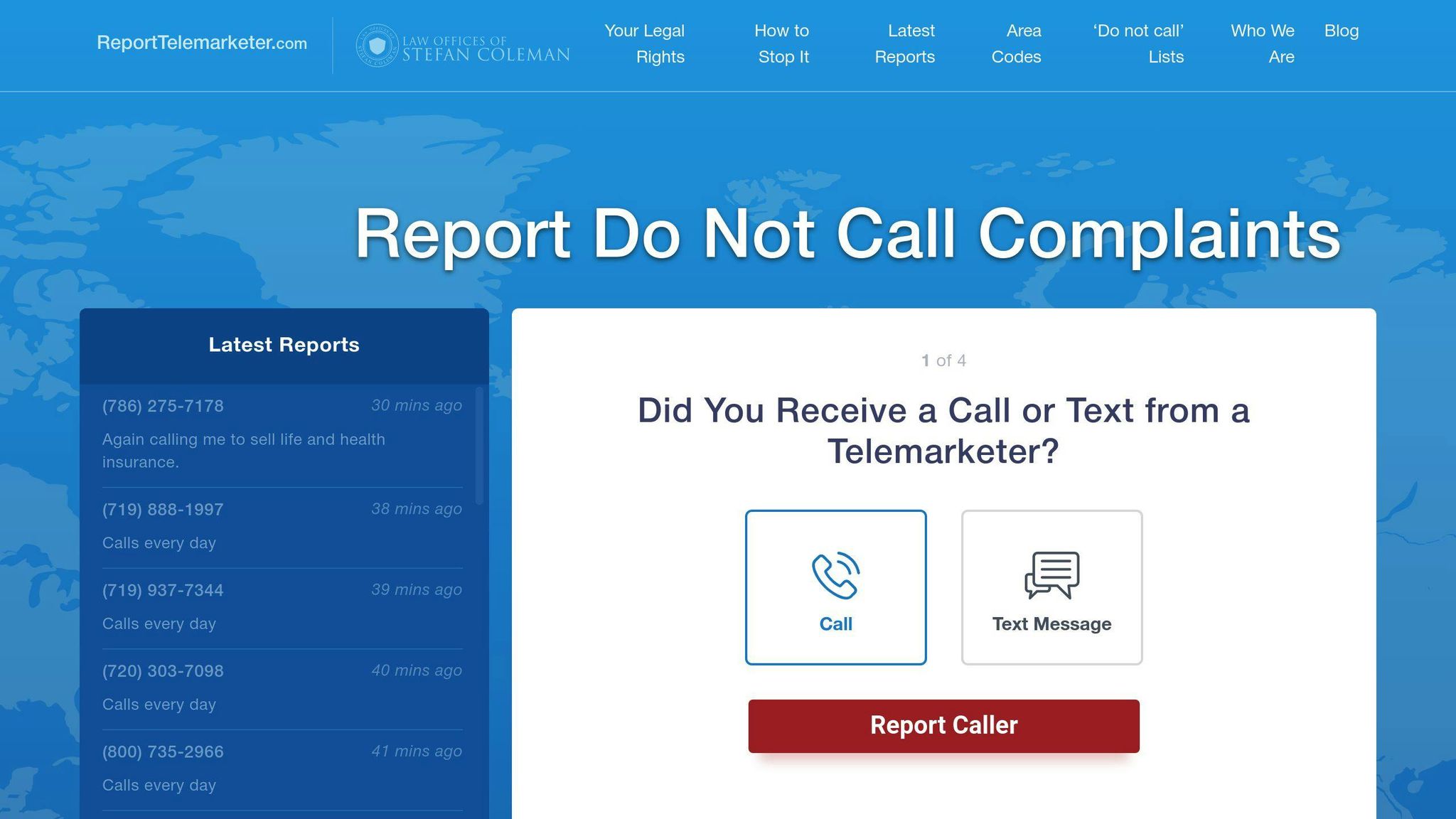
Unwanted telemarketing calls can be frustrating and even illegal. Here’s a quick guide to protect yourself and take action:
- Understand Your Rights: The TCPA (Telephone Consumer Protection Act) protects you from unauthorized robocalls, ensures opt-out options, and enforces time restrictions (no calls before 8 AM or after 9 PM).
- Document Calls: Record details like date, time, caller ID, company name, and call content. Save voicemails or screenshots as evidence.
- Check the Do Not Call Registry: Register your number at donotcall.gov and verify if telemarketers are violating additional rules.
- File an FCC Complaint: Submit details of the violation at fcc.gov/complaints to trigger an investigation.
- Report to the FTC: File a complaint at ftc.gov/complaint to help identify large-scale offenders.
- Seek Legal Help: If violations persist, consult an attorney or use services like ReportTelemarketer.com to pursue compensation under the TCPA.
Quick Tip: Each violation could entitle you to $500–$1,500 in damages. Start by documenting everything and using official complaint channels to stop unwanted calls.
Where Do I File Complaints About Spam Calls?
Step 1: Know Your Rights Under the TCPA
Knowing what the TCPA (Telephone Consumer Protection Act) covers helps you identify and report violations effectively.
What the TCPA Covers
| Protection Type | Details |
|---|---|
| Time Restrictions | Telemarketers cannot call between 9:00 PM and 8:00 AM in your time zone. |
| Automated Calls | Requires your prior written consent for autodialed marketing calls or texts. |
| Transparency & Opt-Out | Caller ID must be accurate, and telemarketers must provide clear opt-out options. |
| Emergency Services | Robocalls to emergency lines and healthcare facilities are strictly banned. |
When Telemarketing Calls Are Allowed
Telemarketers can legally contact you if:
- You’ve given written consent.
- There’s an established business relationship.
- The caller represents a tax-exempt nonprofit.
Even in these cases, calls must still comply with Do Not Call rules, time restrictions, and proper identification requirements.
Violations can lead to hefty penalties, giving you the ability to push back against unwanted calls and hold violators accountable.
Once you understand your rights, the next step is documenting any violations thoroughly.
Step 2: Keep Records of the Telemarketing Call
Keeping detailed records is key to building a strong complaint and holding telemarketers accountable. Accurate documentation gives agencies like the FCC and FTC the tools they need to investigate violations.
Details to Record
| Category | What to Note |
|---|---|
| Caller Information | Date, time, displayed number, company name, representative’s name, callback number |
| Call Content | Purpose of the call, product or service being offered |
| Evidence | Screenshots, voicemails, opt-out attempts, recordings (if allowed by law) |
Use a spreadsheet or notebook to log each interaction. Save voicemails and text messages for reference. Recording the purpose of the call helps regulators decide if it breaches TCPA rules.
How to Gather Caller Information
Take a calm and strategic approach when speaking with telemarketers:
- Politely ask for details like the caller’s name, company, and the reason for the call.
- Write down key information such as a callback number or business address.
For robocalls or automated messages, make note of:
- Any delay before a live person spoke.
- Whether an automated voice or pre-recorded message was used.
- If clear opt-out instructions were provided.
If you plan to record calls, make sure you’re following local recording laws. Proper records not only strengthen your complaint but also support legal actions against persistent offenders.
Once your records are complete, move on to checking your number on the National Do Not Call Registry.
Step 3: Check the National Do Not Call Registry

After keeping track of violations, the next step is to check if your number is listed on the National Do Not Call Registry. This helps confirm whether telemarketers are breaking additional rules. Managed by the FTC, the Registry is a key tool for reducing unwanted telemarketing calls.
Register or Verify Your Number
Head to donotcall.gov to manage your registration. It’s free and straightforward:
- Register: Enter your phone number and email on the website. Confirm your registration by clicking the link sent to your email. It takes up to 31 days for your registration to become active.
- Verify: Use your phone number and email to check if your number is already registered.
| Registration Type | Processing Time | Duration |
|---|---|---|
| New Registration | Up to 31 days | Permanent |
| Business Numbers | Up to 31 days | Limited |
| Mobile Numbers | Up to 31 days | Permanent |
Registry Limitations
It’s important to know the Registry has some exceptions:
- Calls from charitable organizations, political groups, and debt collectors are still allowed.
- Businesses you’ve interacted with in the last 18 months can contact you unless you’ve specifically asked them to stop.
- Automated marketing messages and sales calls remain restricted.
If telemarketing calls persist 31 days after you’ve registered, make sure to document these instances thoroughly. This documentation will be essential when filing a complaint with the FCC.
Once your number is confirmed on the Registry and violations are recorded, you’re ready to take the next step: filing a formal complaint with the FCC.
sbb-itb-a8d93e1
Step 4: Submit a Complaint to the FCC

After confirming your Do Not Call Registry status, the next step is filing a complaint with the Federal Communications Commission (FCC).
How to File a Complaint with the FCC
Head over to fcc.gov/complaints and choose ‘File an Unwanted Call Complaint‘ to begin. The process is straightforward and free. Here’s the information you’ll need:
| Information Needed | What to Include |
|---|---|
| Call Details | Date, time, and the phone number of the caller |
| Company Information | Name of the business and any identifying details |
| Violation Type | Specify if it’s a robocall, telemarketer, or text |
| Documentation | Call logs, recordings, or any supporting evidence |
Make sure to include your Do Not Call Registry status and any previous interactions with the company.
What Happens After You File
Once your complaint is submitted, the FCC will:
- Provide a tracking number for your case.
- Forward your complaint to the service provider involved.
- Require the provider to respond in writing within 30 days.
- Review the case for potential enforcement actions.
While individual complaints take time, they help the FCC identify patterns of abuse and enforce telemarketing laws. Your effort doesn’t just address your issue – it contributes to broader regulation efforts.
If the response to your informal complaint isn’t satisfactory, you have the option to file a formal complaint within six months. Keep in mind, though, that formal complaints come with a $605.00 filing fee and may require legal assistance.
After filing with the FCC, you can also consider submitting a complaint to the FTC, which focuses on broader consumer protection matters.
Step 5: Submit a Complaint to the FTC

The FTC plays a different role compared to the FCC. Instead of addressing individual complaints, the FTC looks for patterns and takes action against large-scale offenders. If your rights under the Do Not Call Registry have been ignored, filing a complaint with the FTC is an important step.
How to File a Complaint with the FTC
To get started, head to ftc.gov/complaint. The system is straightforward, but you’ll need to provide some key details to help their investigation:
| Information Needed | What to Include |
|---|---|
| Call Details | Date, time, caller’s number, and the type of violation (e.g., robocall, scam). |
| Caller Information | Business name, message description, and details of any conversation. |
| Proof or Evidence | Call recordings, screenshots, or any written communication. |
When filling out your complaint, make sure to mention if the caller:
- Kept calling after you asked them to stop.
- Used a prerecorded or artificial voice.
- Called outside allowed hours (before 8 AM or after 9 PM).
- Did not provide their company name.
What Happens After You File
The FTC processes complaints in three key steps:
1. Adding to the Database
Your complaint goes into the FTC’s Consumer Sentinel Network. This database is shared with law enforcement agencies.
2. Looking for Patterns
The FTC reviews complaints to spot trends and identify major offenders. For instance, they recently fined telemarketers $225 million for making one billion illegal robocalls.
3. Taking Action
If enough evidence is gathered, the FTC can issue fines and take legal action. While complaints are usually processed within weeks, larger cases may take longer.
The FTC also shares complaint data with state and federal law enforcement agencies. This collaboration strengthens cases against repeat offenders and increases the impact of your report.
If the problem persists despite filing a complaint, you might need to explore further options, including seeking legal advice.
Step 6: Seek Legal Assistance for Ongoing Issues
If telemarketing violations continue despite filing complaints with the FCC and FTC, it might be time to explore legal options. Persistent violations often indicate a lack of respect for the law and may require stronger measures.
Report to Your State Attorney General
State laws on telemarketing can sometimes be stricter than federal ones. To escalate your complaint, visit your state’s Attorney General website, locate the appropriate complaint form, and provide as much evidence as possible, such as call logs or recordings.
| Step | What to Do | Information Needed |
|---|---|---|
| 1 | Go to the AG Website | Search for your state’s official Attorney General site |
| 2 | Find the Complaint Form | Look under consumer protection or complaints sections |
| 3 | Provide Details | Include dates, times, caller IDs, and a description of violations |
| 4 | Attach Evidence | Upload call recordings, screenshots, or any written communication |
Pursue Legal Action for Compensation
The Telephone Consumer Protection Act (TCPA) allows individuals to seek financial damages from violators, ranging from $500 to $1,500 per incident.
Here’s how to move forward:
- Look for an attorney experienced in TCPA cases.
- Gather all relevant documentation, including call logs and evidence of violations.
- Inquire about free consultations to assess your case.
- Discuss potential outcomes, compensation, and the expected timeline.
Use Services Like ReportTelemarketer.com

Platforms like ReportTelemarketer.com can make the process easier by combining legal expertise with automated tools. They offer their services at no cost, recovering fees directly from violators, which can help strengthen your case with minimal effort on your part.
Conclusion: Protect Yourself from Unwanted Telemarketing Calls
Dealing with telemarketing calls that you don’t want can take some effort, but it’s worth it. Take action, keep detailed records, and use the tools available to you. By documenting violations and reporting them to the FCC and FTC, you not only defend your own rights but also help protect others from similar issues.
| Action Step | Immediate Benefit | Long-term Impact |
|---|---|---|
| Register on Do Not Call Registry | Cuts down on legitimate marketing calls | Provides legal standing for complaints |
| Document Violations | Creates a record for complaints | Helps in potential legal cases |
| File FCC/FTC Complaints | Triggers an official investigation | Strengthens enforcement actions |
| Seek Legal Assistance | Resolves ongoing violations | Could result in compensation |
Understand your rights under the TCPA and take firm action when they are ignored. Free legal services, as mentioned earlier, can be a helpful resource in addressing these issues. With federal tools and legal support, you have everything you need to stand up against telemarketing violations.
FAQs
Here are answers to some common questions about telemarketing violations and filing complaints:
How do I report robocalls to the FTC?
You can report robocalls online at ftc.gov or by calling 1-877-FTC-HELP.
What information should I include in my complaint?
When submitting a telemarketing complaint, make sure to provide:
- Call details: Include the date, time, and phone number.
- Company name: If the caller provided one.
- Evidence: Attach recordings, call logs, or screenshots if available.
- Conversation notes: Briefly describe what was discussed.
What happens after I file a complaint?
Here’s what usually happens once your complaint is submitted:
| Stage | Action | Timeframe |
|---|---|---|
| Initial Review | FCC reviews your complaint | 1-2 business days |
| Provider Investigation | Service provider looks into the issue | Up to 30 days |
What if calls continue after filing complaints?
If the calls don’t stop after filing with the FCC and FTC, here are some steps you can take:
- Contact your state Attorney General’s office for further assistance.
- Explore legal action for violations under the Telephone Consumer Protection Act (TCPA).
- Use free reporting services to strengthen your case.
Under the TCPA, you could be eligible for $500–$1,500 per violation as compensation.
How can I verify my Do Not Call Registry status?
Check your registration status through these options:
- Online: Visit donotcall.gov.
- By Phone: Call 1-888-382-1222.